
Called the Multi-Utility Tactical Transport (MUTT), the vehicles are being developed by General Dynamics. They’re around the size of an ATV, and are available in four-wheeled, six-wheeled, or eight-wheeled tracked variations — providing a maximum of 1,200-pound payloads. The MUTT can function in one of two modes: either semi-autonomous, which means as a “controller-less small unit robotic follower,” or remote-controlled using a tablet or joystick.
However, the ambition is that over time they will evolve to be smarter in a way that will make them even more valuable for working alongside humans.
“Eventually, what we hope to do is go to systems that are more truly autonomous, that I can say, ‘Hey, go cover my right flank,’ and it’s going to go do the things it needs to do in order to make that happen,” a senior marine told Business Insider. “Then if it does get in the situation where the weapons systems malfunction, it can either fix itself, or then I’ve got to send a marine to go fix it.”
The versatile robots are primarily designed to transport food, water, and assorted other supplies, although the addition of a powerful machine gun opens up a variety of possibilities for engaging enemies or providing cover.
As with any area subject to automation, military applications require examination about exactly which tasks we’re happy to hand over to machines. No-one would suggest that a marine can be replaced by an ATV with a .50-caliber machine gun. But the advantages of a battlefield ally that doesn’t ever get fatigued, doesn’t need water, and can constantly support you with equipment in the field are also pretty clear.
Because some combination of the world’s best-trained military commandos and a gun-toting robot have to intimidate any possible opposition, right?
Editors' Recommendations
- U.S. Air Force’s secretive space plane bags prestigious aerospace award
- SpaceX and United Launch Alliance win launch contracts for U.S. Air Force
- The U.S. Air Force’s secretive space plane ends record-breaking mission
- U.S. Navy is working on making its fleet invisible to computerized surveillance
- Parrot to build small surveillance drones for U.S. soldiers on the battlefield


